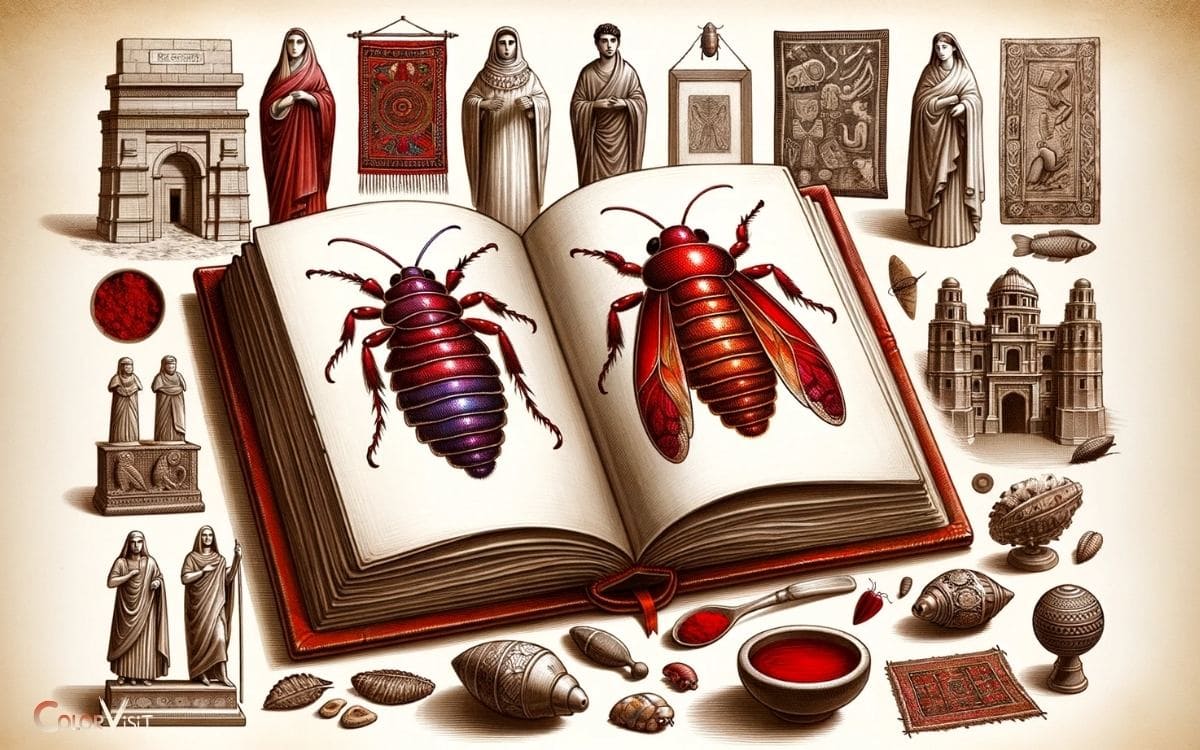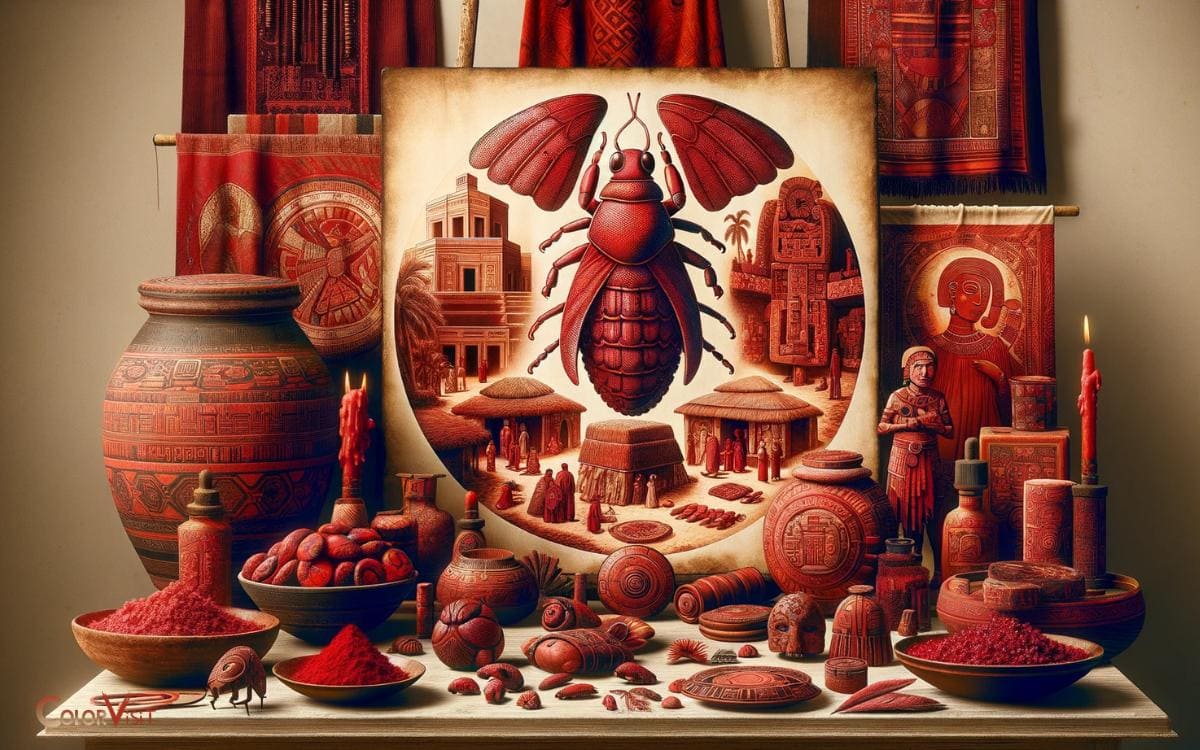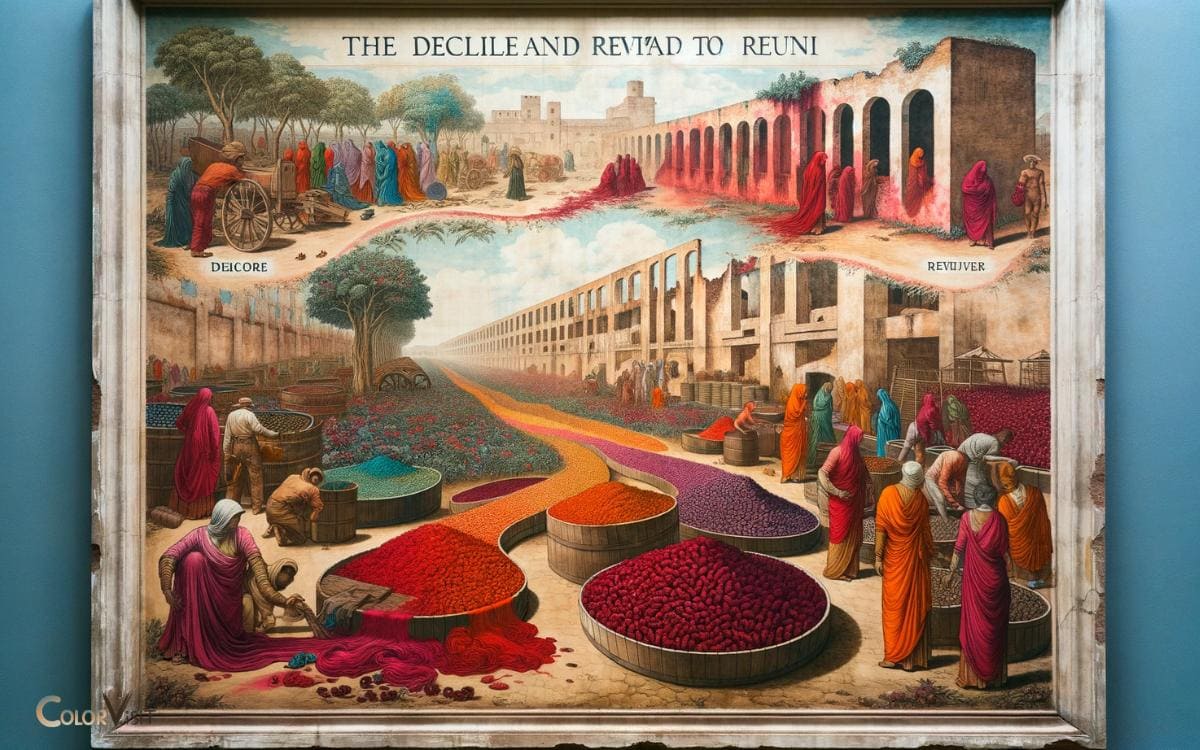Cochineal Red the Art History of a Color: Insect!
Cochineal Red is a dye that comes from the cochineal insect.
The color’s brilliance made it popular among ancient civilizations and later in European art. Its history is woven with fascinating tales of its production, where the insects are harvested for their vibrant hue.
The symbolism of Cochineal Red varies across cultures, often associated with power and luxury. In modern times, there’s been a revival of its use, showcasing its enduring appeal.
Cochineal Red’s journey from a tiny insect to a globally sought-after pigment is a testament to its enduring appeal and cultural significance. Its vibrant shade and symbolic power continue to influence art and culture.
Key Takeaway
Origins of Cochineal Red
The origins of Cochineal Red can be traced back to the indigenous cultures of Central and South America, where the cochineal insect was used as a source of vibrant red dye.
- The use of cochineal dates back to the pre-Columbian era, where it held significant cultural and economic value.
- Aztecs and Mayans utilized cochineal as a prestigious commodity, reserved for the elite and for religious ceremonies.
- The insect’s carminic acid, responsible for its intense red color, was extracted by crushing the female cochineal insects.
- This process led to the production of a highly prized dye, known for its colorfastness and rich, deep hues.
The historical significance of cochineal in the Americas laid the foundation for its later introduction to Europe and its widespread use in art, textiles, and cosmetics.
Cochineal Red in Ancient Civilizations
In ancient civilizations of Central and South America, cochineal red played a significant role in cultural practices and trade, with its vibrant hue derived from the carminic acid of the cochineal insect.
The use of cochineal red can be traced back to civilizations such as the Aztecs, Mayans, and Incas, where it held deep cultural and religious significance, often reserved for the elite and sacred rituals.
The table below provides a snapshot of the utilization of cochineal red in these ancient civilizations, showcasing its diverse applications across various aspects of society.
| Civilization | Application | Significance |
|---|---|---|
| Aztecs | Textiles and Cosmetics | Reserved for royalty and religious ceremonies |
| Mayans | Paintings and Murals | Symbolized blood and life, used in religious ceremonies |
| Incas | Ceremonial Offerings | Valued as a commodity and tribute in trade and commerce |
The ancient civilizations revered cochineal red for its intense color, and its impact on art and culture was profound.
Cochineal Red in European Art
The use of cochineal red in European art has been prominent throughout history, particularly in Renaissance masterpieces where it was a favored pigment for creating rich, vibrant hues.
The symbolism of cochineal red in Baroque paintings also played a significant role, often representing power, wealth, and the divine.
Presence in Renaissance Masterpieces
Renaissance masterpieces prominently feature a rich and vibrant use of Cochineal Red, adding depth and intensity to the European art of the era.
- Artists such as Titian, Veronese, and Raphael utilized this striking pigment to evoke passion, power, and opulence in their works.
- The intense, warm tones of Cochineal Red were often employed to depict regal robes, sumptuous fabrics, and the flushed cheeks of subjects, infusing their representations with a sense of vitality and emotion.
- Its application in the art of this period not only showcased the technical prowess of the artists but also reflected the cultural and societal significance of the color.
- The presence of Cochineal Red in Renaissance masterpieces not only transformed the visual landscape of European art but also symbolized the dynamic shifts in artistic expression and representation.
This transitioned seamlessly into the subsequent section about the symbolism in baroque paintings.
Symbolism in Baroque Paintings
During the Baroque period, the use of Cochineal Red in European art held symbolic significance, conveying themes of power, passion, and religious devotion.
This vibrant pigment was utilized by Baroque artists to evoke specific emotions and concepts in their paintings.
The symbolism of Cochineal Red in Baroque art is exemplified through:
- Power and Wealth: The rich, deep hues of Cochineal Red were often used to depict the opulence and grandeur of the ruling class, symbolizing their authority and prosperity.
- Passion and Drama: In religious and secular works, the intense color of Cochineal Red was employed to evoke strong emotions, particularly in portraying scenes of martyrdom, love, and intense human experiences.
- Spirituality and Devotion: In religious paintings, Cochineal Red symbolized the blood of Christ, emphasizing themes of sacrifice, salvation, and divine love.
- Contrast and Drama: The vivid contrast of Cochineal Red against dark backgrounds heightened the dramatic impact of Baroque compositions, drawing the viewer’s attention and creating a sense of dynamism.
The Production of Cochineal Red
Cochineal red is derived from the bodies of female cochineal insects, which are harvested and processed to extract the vibrant red pigment used in art and textiles.
- The process begins by carefully collecting the tiny insects from the prickly pear cacti they inhabit.
- Once collected, the insects are dried and then crushed to create a fine powder. This powder is then subjected to various extraction methods, such as soaking in water or acidic solutions, to release the intense red color.
- The extracted pigment undergoes further processing to create various forms, including powder, paste, or liquid dye, suitable for different artistic and textile applications.
- The meticulous production process ensures the purity and richness of cochineal red, making it a prized colorant in the art world.
This intricate production process not only yields a visually stunning color but also holds deep symbolism and significance in art history.
Symbolism and Significance of Cochineal Red
The symbolism and significance of cochineal red in the art world have deep historical roots and cultural implications, reflecting its revered status as a colorant with profound meaning.
- Royal Connotations: Historically, cochineal red was associated with royalty and power, often reserved for the clothing and textiles of nobility.
- Religious Symbolism: In many cultures, the color held religious significance, symbolizing devotion, spirituality, and sacrifice.
- Artistic Expression: Artists utilized cochineal red to convey emotions such as love, passion, and intensity in their works, adding depth and emotional resonance to their creations.
- Cultural Identity: Cochineal red became intertwined with the cultural identity of civilizations, representing heritage, tradition, and the richness of cultural diversity.
The enduring allure of cochineal red lies in its multifaceted symbolism, making it a color of profound historical, cultural, and artistic significance.
The Decline and Revival of Cochineal Red
The decline and subsequent revival of cochineal red as a prominent artistic and industrial pigment marks an intriguing journey in the realm of color history.
In modern art, the resurgence of interest in natural dyes has led to a re-evaluation of cochineal’s place in artistic expression and the broader cultural context.
Additionally, the exploration of sustainable dye alternatives has further fueled discussions about the potential for cochineal red to reclaim its historical significance in contemporary creative practices.
Cochineal in Modern Art
The decline of Cochineal Red in the 19th century led to a shift towards synthetic dyes.
However, in modern art, there has been a revival of interest in natural and traditional materials, leading to a resurgence of Cochineal Red.
This revival has influenced modern art in several ways:
- Color Vibrancy: Artists are drawn to the intense and unique hue of Cochineal Red, adding depth and richness to their work.
- Sustainability: In an era of environmental consciousness, the resurgence of Cochineal Red aligns with the demand for sustainable art materials.
- Historical Connection: Using Cochineal Red connects modern artists to the rich history of art and dyeing traditions.
- Innovation: Artists are exploring new ways to utilize Cochineal Red, blending traditional techniques with modern artistic expressions.
This resurgence in the usage of Cochineal Red has sparked a broader conversation about sustainable dye alternatives.
Sustainable Dye Alternatives
The historical decline of Cochineal Red led to a shift towards synthetic dyes in the 19th century, but its subsequent revival has sparked a broader conversation about sustainable dye alternatives, aligning with the demand for environmentally conscious art materials.
This resurgence has prompted artists and researchers to explore natural dyes derived from plants, minerals, and other sustainable sources.
| Criteria | Cochineal Red | Sustainable Dye 1 | Sustainable Dye 2 |
|---|---|---|---|
| Color Vibrancy | High | Medium | High |
| Lightfastness | Excellent | Good | Excellent |
| Environmental Impact | Concerning | Low | Negligible |
This analytical approach allows artists to make informed decisions about incorporating sustainable dye alternatives into their creative practice.
Contemporary Use of Cochineal Red
Contemporary artists continue to utilize cochineal red as a vibrant and versatile medium for creating striking visual compositions.
The contemporary use of cochineal red in art and design reflects its enduring appeal and relevance in the modern creative landscape.
Some of the ways in which contemporary artists are incorporating cochineal red include:
- Textile Art: Cochineal red is being used to dye fabrics and yarn, resulting in rich and lustrous textiles that add depth and complexity to contemporary textile art.
- Painting and Mixed Media: Artists are employing cochineal red as a bold and expressive pigment in paintings and mixed media artworks, harnessing its intense color and unique properties to create visually captivating pieces.
- Installation Art: Cochineal red is being utilized in large-scale installation pieces, where its vivid hue and organic origins bring a dynamic and immersive quality to the artwork.
- Digital Art: Even in the digital realm, artists are incorporating cochineal red, either by digitally manipulating its color or by using it as a thematic element, showcasing its adaptability across various artistic mediums.
Conclusion
Intricately woven into the tapestry of art history, Cochineal Red has left an indelible mark on ancient civilizations, European art, and contemporary use.
Its rich origins and production process have imbued it with symbolism and significance, making it a color of cultural and artistic significance.
Despite a decline, Cochineal Red has experienced a revival, continuing to captivate and inspire artists and audiences alike with its vibrant and enduring presence.








